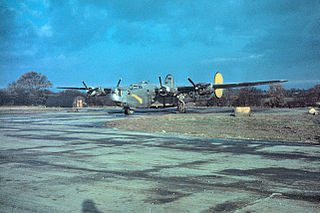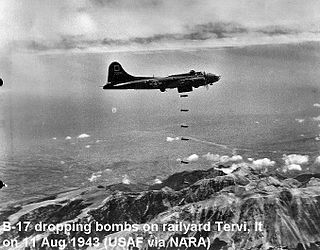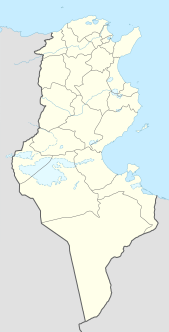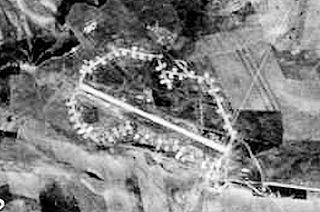
Mohamed Khider Airport or Biskra Ouakda Airport is an airport in Algeria, located approximately 12 km north-northeast of Oumache; about 200 km south-southwest of Constantine.

The 493d Bombardment Group is a former United States Army Air Forces unit that was assigned to the 92d Bombardment Wing during World War II. It the last bombardment group to be assigned to Eighth Air Force. It flew combat missions in the strategic bombing campaign against Germany until shortly before V-E Day, then returned to the United States for inactivation. In 2002, the group was converted to provisional status as the 493d Air Expeditionary Group and assigned to Air Mobility Command to activate or inactivate as needed.

The 490th Bombardment Group is a former United States Army Air Forces unit. The group was activated in October 1943. After training in the United States, it deployed to the European Theater of Operations and participated in the strategic bombing campaign against Germany from 31 May 1944 to 20 April 1945, losing 22 aircraft while flying more than 5,000 sorties. Following V-E Day, the group returned to the United States, where it was inactivated in November 1945.

Mareeba Airfield is an airfield located 4.3 nautical miles south of Mareeba, Queensland, Australia. Built in 1942 as a US Army Air Force base during World War II, the airfield had two runways, with a complement of taxiways, hardstands and a containment area. After the war, much of the airfield reverted to agricultural use, while the southern runway remains as an active airfield.

The 847th Bombardment Squadron is an inactive United States Army Air Forces unit. Its last assignment was with the 489th Bombardment Group at Great Bend Army Air Field, Kansas where it was inactivated on 28 March 1945. The squadron performed antisubmarine patrols in 1942 and 1943. After reforming as a heavy bomber squadron, it engaged in combat in the European Theater of Operations until returning to the United States in late 1944. The squadron was inactivated while its parent group was training as a very heavy bombardment unit.

Chateaudun-du-Rhumel Airfield is an abandoned military airfield in Algeria, located about 6 km north-northwest of Chelghoum el Aid, in Mila province, about 47 km southwest of Constantine.

Ain M'lila Airfield is an abandoned World War II military airfield in Algeria, located approximately 17 km north-northwest of Aïn Kercha in Oum el Bouaghi province, about 50 km south-southeast of Constantine. It was built by the Army Corps of Engineers on a flat, dry lakebed at an altitude of 2580 feet, designed for heavy bomber use by the United States Army Air Force Twelfth Air Force during the North African Campaign with concrete runways, hardstands and taxiways. Billeting and support facilities consisted of tents. Due to its high altitude, the days were hot and the nights cold. Known units which operated from Ain M'lila were:

Saint-Donat Airfield was a World War II military airfield in Algeria, located near Tadjenanet in Mila Province; approximately 63 km southwest of Constantine. It was used by the United States Army Air Force Twelfth Air Force as a heavy bomber airfield during the North African Campaign. Known units assigned to the field were:

Bizerte-Sidi Ahmed Air Base is a Tunisian Air Force base located approximately 7 km west of Menzel Abderhaman, and 9 km west-southwest of Bizerte.

Depienne Airfield is a World War II airfield in Tunisia, located approximately 12 km northeast of El Fahs, and 53 km southwest of Tunis. The airfield was first used by the German Luftwaffe in 1941 and 1942, and was captured by the British Army by a parachute attack on 3 December 1942. It was later used by the United States Army Air Force Twelfth Air Force as a B-17 Flying Fortress heavy bomber airfield during the North African Campaign.

Enfidaville Airfield is an abandoned World War II military airfield in Tunisia, located approximately 13 km north-northwest of Harqalah; approximately 90 km southwest of Tunis. It was used by the United States Army Air Force Twelfth Air Force during the North African Campaign as a B-17 Flying Fortress heavy bomber ant troop carrier base. Known units assigned were:

Pont du Fahs Airfield is an abandoned military airfield in Tunisia, which was located approximately 6 km west-southwest of El Fahs, and 55 km southwest of Tunis.

Oudna Airfield is an abandoned World War II military airfield in Tunisia, which was located approximately 7 km southwest of La Mohammedia; about 14 km south-southwest of Tunis It was used by the United States Army Air Force Twelfth Air Force during the North African Campaign as a heavy B-17 Flying Fortress bomber airfield. Known units assigned were:

Marcianise Airfield is an abandoned World War II military airfield in southeast Italy, which is located approximately 10 km north-northwest of Marcianise in the province of Caserta, Campania; about 32 km north-northwest of Naples. Built in 1943 by United States Army Engineers, the airfield was a large facility capable of handling heavy bombers built for Fifteenth Air Force, which stationed B-17s at the field after the war, prior to their return to the United States. However its primary use was by Air Technical Service Command and by Twelfth Air Force tactical fighter bomber units during the Italian Campaign.

Tortorella Airfield is an abandoned World War II military airfield in Italy. It was located 9.4 Kilometers east-northeast of Foggia, in the Province of Foggia. The airfield was abandoned and dismantled after the end of the war in 1945.

Sterparone Airfield is an abandoned World War II military airfield in Italy. It was located 11.1 Kilometers south-southeast of San Severo, in the Province of Foggia. The airfield was abandoned and dismantled after the end of the war in 1945.

The 832d Bombardment Squadron is an inactive United States Army Air Forces unit. It trained as a Consolidated B-24 Liberator unit, and deployed with its planes to the European Theater of Operations, entering combat on 7 May 1944. In July 1944, the squadron converted to Boeing B-17 Flying Fortresses, continuing combat with the 486th Bombardment Group until April 1945. Following V-E Day it returned to Drew Field, Florida, where it was inactivated on 7 November 1945.

The 348th Reconnaissance Squadron is an active United States Air Force unit. It is assigned to the 69th Reconnaissance Group. It was activated at Grand Forks Air Force Base, North Dakota on 19 September 2011.

The 483d Airlift Group is an inactive unit last assigned to Pacific Air Forces at Osan AB Korea. It was assigned to Twenty-Second Air Force as a VIP transport unit for Headquarters, Seventh Air Force. It was inactivated on 1 June 1992.

The Mediterranean Theater of Operations (MTO) was the second-largest user of the B-17 Flying Fortress during World War II. There were a total of six combat groups equipped with the bomber assigned to the Theater.























